A modified form of grafting in which only a bud is inserted in the root stock. The method is widely used in horticulture, but can also be used for forest trees. Graft budding may have a preference in following instances:
Two general preconditions for budding should be observed:
Several methods of budding are used. some of the most common methods are shown on the next page.
a) T-budding
 | 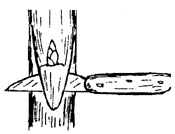 |  |
| A T-formed cut is made in the root stock vertical about 2.5 cm, horizontal about ⅓ of circumference. | A slicing cut of the budstick is made from ca. 2.5 cm under the bud to 2 cm above. The shield is cut free with a horizontal cut ≈2 cm above the bud. | The bark of the T-formed cut in the stock is opened. The shield is inserted by pushing it downwards under the two flaps of bark. |
| T-budding is used for forest and fruit trees with a diameter of 6–25 mm and a relatively thin and flexible bark that can easily be lifted. An inverted T-cut in the root stock is sometimes used in order to avoid water entrance. The bud should then be prepared correspondingly with the straight cut at the proximal end. | ||
b) Patch budding
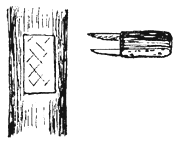 | 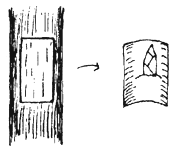 |  |
| Two parallel horizontal cuts are made on the root stock, about ⅓ of the circumference using a double bladed knife. The two cuts are connected at each side by vertical cuts and the patch is removed. | The budstick is cut similar to the root stock, horizontal with a double bladed knife and vertical at each side. The bud is removed. | The bud patch is inserted into the patch hole in the root stock. The patch may need to be trimmed at one side in order to make a tight fit. |
| Used for forest and fruit trees with a relatively thick bark. The budstick should not be larger than ≈25mm in diameter while the root stock may be up to 10 cm thick. The bark should be approximately the same thickness. | ||
c) I-budding
 | 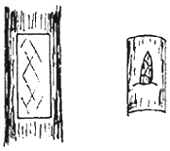 |  |
| Two parallel cuts are made on the root stock using a double bladed knife. The middle of the two cuts are connected, using a vertical cut. | The patch containing the bud is cut off by the help of the two bladed knife. | The two sides of the bark of the I-formed cut is lifted and the bud patch is inserted. |
| Modified patch budding used when the bark of the stock is considerably thicker than that of the budstick. | ||
d) Chip budding
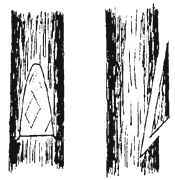 | 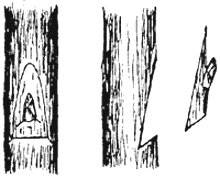 | 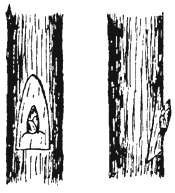 |
| Root stock: First cut is made at an angle of 45° downwards, ¼ of the diameter. Second cut is made ≈ 25 mm above the first, going downwards, to meet the first cut. | Budstick: Cut as for the root stock. First cut is made 6 mm below the bud. Second cut is made ≈ 13 mm above the bud going downwards to meet the first cut. The bud with attached wood is removed. | The bud is inserted in the root stock. |
| Chip budding is used for small material 12–25 cm in diameter. Its main use is that it can be applied outside the active growth season when the bark is not slipping. | ||
Note: Buds possess polarity. It is important that the bud is inserted in the right position, i.e. not upside down.
Once the bud has been inserted in the root stock the union is wrapped and sometimes waxed. Care should be taken that the bud is not damaged and that the bud is left fully exposed, i.e. not covered with wrapping material or wax. When the two parts have united and the bud sprouted, the top or the stock can be cut.
